William Morris - Table of Contents ............ Arts & Crafts - Table of Contents
William Morris Stained Glass
at the
Victoria & Albert Museum, London, England
"St. George" - Stained Glass Series  "Saint George" - Panel 1 Source of information below: Albert & Victoria Museum (online Dec. 2016) Rossetti, Dante Gabriel, born 1828 - died 1882 (designer) ... Morris, Marshall, Faulkner & Co.(maker) ... Place of origin: England (made) ... Ca. 1862 (made) ... Materials and Techniques: Stained and painted glass ... Museum number: C.319-1927 ... Gallery location: British Galleries, room 125f, case WN The firm of Morris, Marshall, Faulkner &
Co. was founded in 1861 and dedicated much energy to making stained
glass for secular use. This panel, the second of six relating the
legend of St George and the Dragon, depicts 'How the damsels of the
court cast lots who should be the Dragon's meat and how the lot fell to
the King's daughter'. The series was believed to have been made to
decorate windows at Harden Hall in Bingley, West Yorkshire. Morris
& Co. soon built up an extensive repertoire of designs which could
be reproduced or adapted for new commissions.
This series was designed by Dante Gabriel
Rossetti (1828-1882). Following his preoccupations with the
Pre-Raphaelite Brotherhood, he came into contact with William Morris
and Edward Burne-Jones in 1856. They shared an enthusiasm for the
legendary past and expressed it in narrative cycles such as this.
Rosetti produced considerably fewer cartoons for stained-glass windows
than others in the group, and his interest in the medium died out after
a few years.
Morris & Co. lacked the technical expertise
to make the glass for their designs, but bought it from the London
glassmakers James Powell & Sons. A wide range of high quality 'pot
metal' (coloured glass) is used in this panel. The olive greens and
rich, dark reds, juxtaposed with dazzling areas of gold and white, are
characteristic of the innovative palette used throughout the series.
 "Saint George" - Panel 2  "Saint George" - Panel 3  "Saint George" - Panel 4 |
|
"King René's Honeymoon" - Panel 1
Source of information below: Albert & Victoria Museum (online Dec. 2016) Burne-Jones, Edward Coley (Sir) ... Morris, Marshall, Faulkner & Co. ... Clear and coloured glass with painted and stained details ... London (made) ... 1862 (made) ... Museum number: CIRC.517-1953 ... British Galleries, room 122d, case WE Decorated glass windows have long been
associated with ecclesiastical buildings but, from the latter part of
the Middle Ages, domestic interiors were also furnished with such
windows. Medieval-style stained glass windows were revived in the 19th
century and the firm of Morris, Marshall, Faulkner & Co. was
commissioned to create windows for both ecclesiastical and domestic
settings. This panel comes from Myles Birket Foster's library window.
In 1861 the artist Myles Birket Foster (1825-1899) embarked upon the building of his Surrey home, 'The Hill', in Whitley. He chose the recently established firm of Morris, Marshall, Faulkner & Co., who promoted functionalism in design and high standards of craftsmanship, to design its interior. Depicting 'Architecture', this window is one of a series of four imaginary episodes from the honeymoon of King René of Anjou, said to have been inspired by Sir Walter Scott's popular novel 'Anne of Geierstein'. Though the novel was a favourite of Foster's, the series was originally designed to decorate a cabinet commissioned by the architect John P. Seddon (1827-1906). The cabinet was among the furniture shown at the International Exhibition of 1862. The King René series was devised, and this particular panel designed, by Ford Madox Brown (1821-1898), one of the original partners of Morris & Co. Fashioned in jewel-like colours, it encapsulates the principles of 'invention, expression and good dramatic action' that Brown considered so important to stained-glass art.
Detail below:
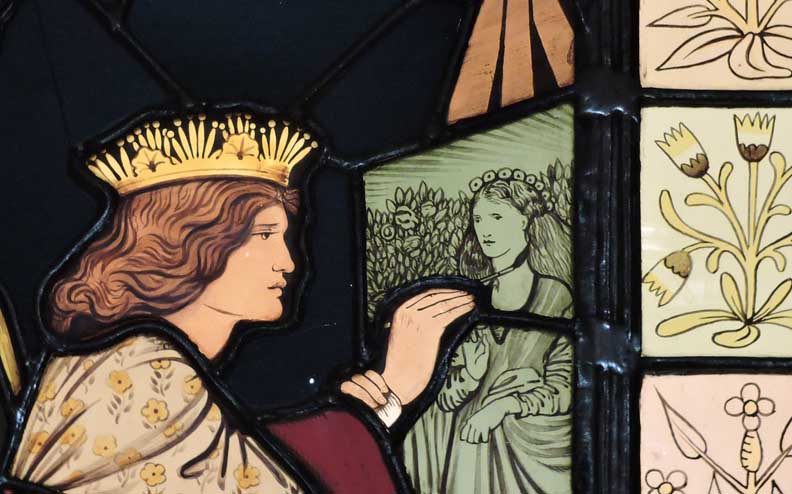 Panel 1 - Detail
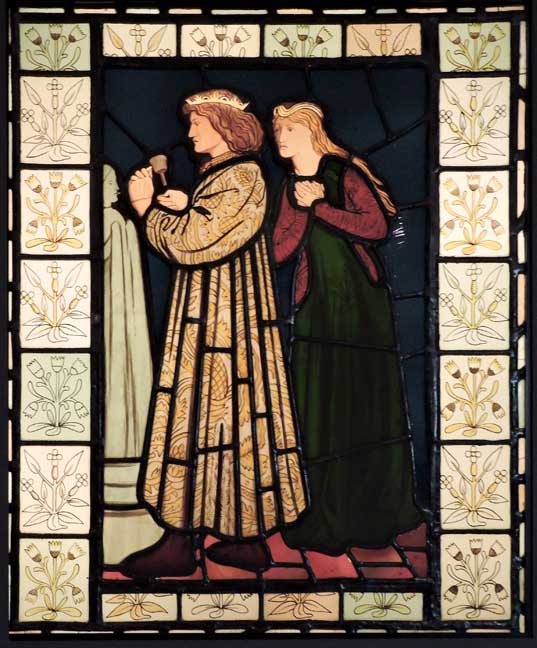 "King René's Honeymoon" - Panel 2
Source of information below: Albert & Victoria Museum (online Dec. 2016) Burne-Jones, Edward Coley (Sir), born 1833 - died 1898 (designer) ... Morris & Co. (maker) ... Stained and painted glass ... Ca. 1863 (made) ... Museum number: CIRC.518-1953 ... British Galleries, room 122d, case WE This
panel comes from Myles Birket Foster's library window.
In 1861 the artist Myles Birket Foster (1825-1899) embarked upon the building of his Surrey home, 'The Hill', in Whitley. He chose the recently established firm of Morris, Marshall, Faulkner & Co., who promoted functionalism in design and high standards of craftsmanship, to design its interior.
Detail below:
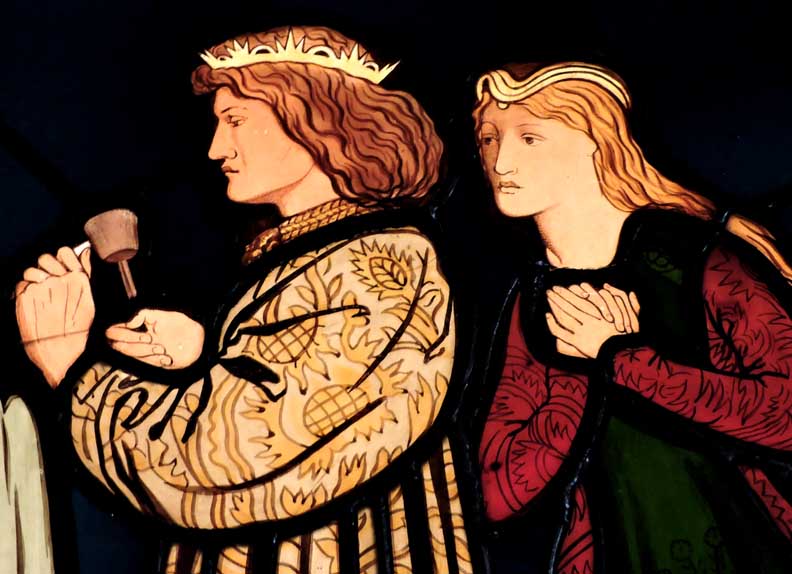 Panel 2 - Detail 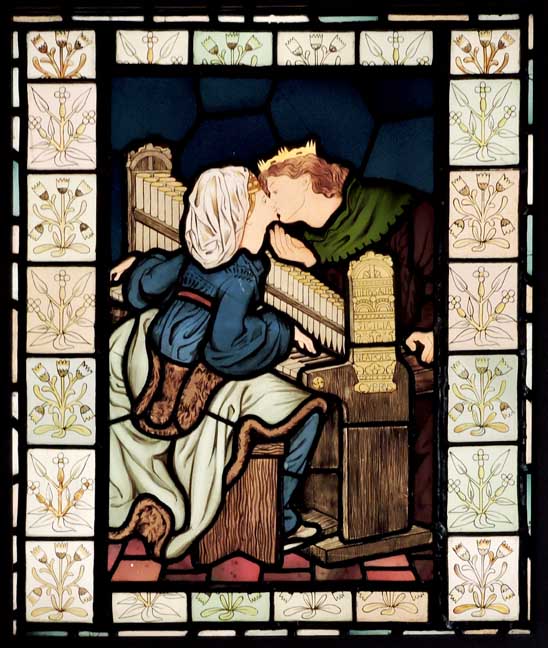 "King René's Honeymoon" - Panel 3 Source of information below: Albert & Victoria Museum (online Dec. 2016) Rossetti, Dante Gabriel, born 1828 - died 1882 ... Morris & Co. ... Stained and painted glass ... London (made) ... Ca. 1863 (made) ... Museum number: CIRC.519-1953 ... British Galleries, room 122d, case WE This panel comes from Myles Birket Foster's library window.
"King René's Honeymoon" - Panel 4
Source of information below: Albert & Victoria Museum (online Dec. 2016) Brown, Ford Madox, born 1821 - died 1893 (designer) ... Morris, Marshall, Faulkner & Co. (maker) ... Stained and painted glass ... London (made) ... 1862 (made) ... Museum number: CIRC.516-1953 ... British Galleries, room 122d, case WE This
panel comes from Myles Birket Foster's library window.
Detail below:
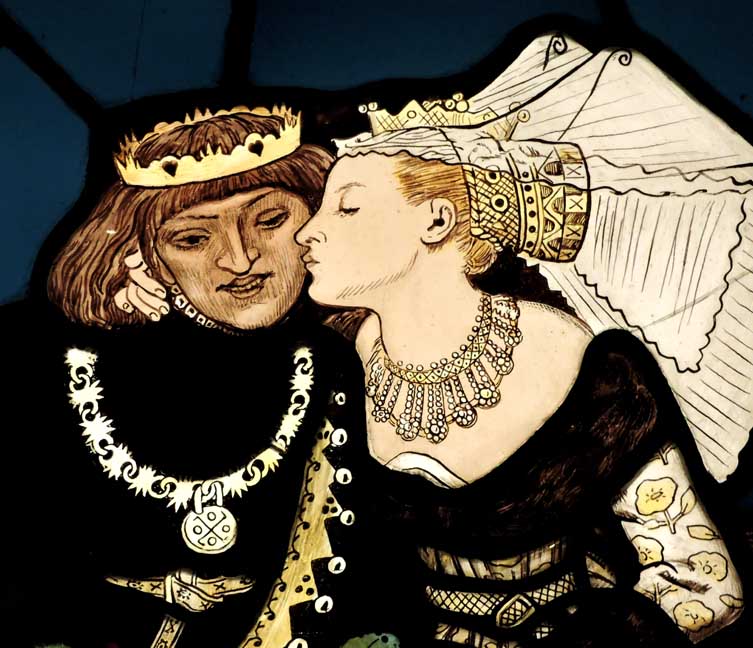 Panel 4 - Detail
|
 "Legend of Good Women" Source of information below: Albert & Victoria Museum (online Dec. 2016) Burne-Jones, Edward Coley (Sir), born 1833 - died 1898 (designer) ... Morris, Marshall, Faulkner & Co. (maker) ... 1864 ... Clear and coloured glass, painted with brown pigment and yellow (silver) stain ... England (made) ... Museum number: 774-1864 ... British Galleries, room 125f, case WS This stained glass panel is
originally from a series of seven depicting scenes from the 'Legend of
Good Women'. The 'Legend of Good Women' was written by Geoffrey Chaucer in the
1380s. It is an epic poem written in iambic pentameter describing how
the personification of 'Amor' came to him in his sleep and related the
stories of ten women from antiquity, all of whom suffered for love. The
imagery on this panel shows Chaucer asleep in his bower, prior to the
visitation and revelations of Amor. Burne-Jones first used this theme in a series of tiles he designed for the firm in 1862, and again for an embroidery in 1863; the latter was never executed. In 1864, Burne-Jones designed a set of 7 stained glass windows with this theme for Myles Birket Foster's house, The Hill, in Witley, Surrey. This panel is from another series of the same theme which were made specifically for the Exhibition of Stained Glass, Mosaic, etc. held at the South Kensington Museum (later the Victoria & Albert Museum) in 1864. 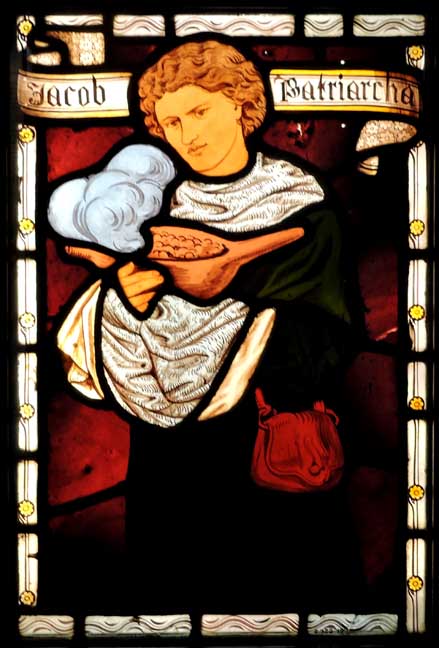 "Jacob and the Mess of Pottage" Source of information below: Albert & Victoria Museum (online Dec. 2016) Rossetti, Dante Gabriel, born 1828 - died 1882 ... Morris, Marshall, Faulkner & Co. (maker) ... England (made) ... Ca. 1863 (made) ... Museum number: C.322-1927 ... Sacred Silver & Stained Glass, room 83 The firm of Morris, Marshall, Faulkner & Co. was
established in 1861. It employed artists such as Dante Gabriel Rossetti
and Edward Burne-Jones, who were instrumental in starting a new trend in the design of stained glass.
The Gothic Revival was a ‘boom period’ for church building and furnishing. But most of the stained glass that was created was noted for its slavish copying of medieval glass. Morris and his friends moved away from this historicism. Their designs for stained glass show a remarkable freedom in style and a softening in the choice of colours and tones. In 1864 the firm completed a series of windows for the Cathedral of St Peter in Bradford. Dante Gabriel Rossetti designed many panels for these windows, including a full-length version of Jacob and the Mess of Pottage. The panel here is probably a trial piece that was never displayed. Jacob was one of the Old Testament patriarchs. He was the younger of the twin sons of Isaac, Abraham’s son. The older twin, Esau, was meant to inherit everything. When Esau returned from a long journey, Jacob offered him a mess of pottage to satisfy his hunger. In exchange, he was to give Jacob his birthright as the elder son. Esau agreed to the exchange. In medieval schemes, this Old Testament story often prefigures the Betrayal of Christ by Judas. Detail below: 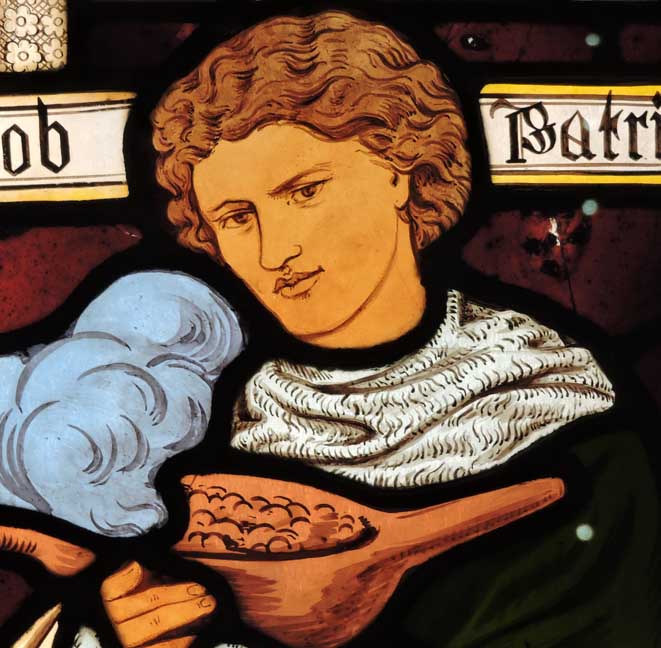  "Penelope" Source of information below: Albert & Victoria Museum (online Dec. 2016) Burne-Jones, Edward Coley (Sir), born 1833 - died 1898 (designer) ... Morris, Marshall, Faulkner & Co. ... Ca. 1864 ... Stained and painted glass panel ... Place: England By the 19th century, stained glass was being used almost exclusively to embellish church interiors. The Arts & Crafts firm Morris, Marshall, Faulkner & Co. (founded in 1861), was instrumental in reintroducing the medium to the home. This panel was designed by Edward Burne-Jones (1833-1898), the most prolific and influential of the stained-glass designers working with William Morris during this period. This panel is one of four purchased from an exhibition of contemporary stained glass held at the South Kensington Museum in 1864. This roundel is one of a series of designs which depicts the 14th-century poet Geoffrey Chaucer (died 1400) and six characters from his poem 'Goode Wimmen' (Good Women). The heroine represented here - Penelope - whilst not featured in Chaucer's own tale, was famous as the model of domestic virtue in Homeric legend. Burne-Jones adapted the design for this roundel from the head of Phyllis who appeared in another of the artist's 'Goode Wimmen' series. Adapting an existing design for several different commissions seems to have been common practice among those working for Morris & Co. Indeed, this same series had previously been used by Burne-Jones to decorate a set of tiles, an embroidered frieze, as well as forming the basis for at least three different stained-glass compositions. |
